Just like the Tire Training Exercises, Isometric workouts are another form of strength training exercises, which uses the muscle contractions to enhance strength and endurance. Isometric exercises are mostly low intensity static exercises in which the joint angle and muscle length don’t change much. Resistance in isometric workouts is mostly provided by the person’s own body weight along with occasional use of free weights.
The history of isometric workout is thousands of years old and mention of isometric exercise such as static holds has been seen in ancient yoga and martial arts. Bruce Lee, the master of martial arts himself used to practice these forms of workouts to improve his strength, stamina and control. Presently, isometric workout routine holds an important place in bodybuilding and it is soaring in popularity because of its flexibility and easy approach.
What are Isometric Exercises?
Isometrics are actually static in nature and usually occur following the eccentric or concentric portion of the movement. So, although the muscle contracts, the joint angle and muscle lengths do not change.
The muscle can contract in a number of ways. It contracts to minimize the distance between joints, an example is when you do a bicep curl.
This is called a concentric contraction, where the muscle tenses while shortening.
Everyday movements such as lowering a load or lowering a weight, enables the muscle to tense while you lower a load. This eccentric movement (name of the movement) occurs when the muscle tenses while it lengthens.
There is a final type of contraction known as an isometric contraction, which occurs when the muscle tenses while the length does not alter. Examples of this are poses in body building or pushing against an immovable object such as a wall.
Benefits of Isometric Exercises
Isometric exercises involve the contraction of a specific set of muscles that are effective enough to increase muscle strength and stability. There are several benefits of practicing isometric exercises and being a form of low intensity workout it can be done by almost anyone.
Take Minimal Time – The isometric exercises can be completed in minimal time and require no equipment at all. It uses the weight of the body for strength training.
Improve Flexibility – Regular practice of isometric exercises enhances overall flexibility of the body, thereby minimizing the risk of injuries and strains.
Increase Strength – Isometric workouts are great for boosting strength and lean muscle mass because it is the only form of training that activates almost all the motor units at the same time.
Ideal for Recovery from Injury or Arthritis – Being static and low intensity exercises, isometric workouts are ideal for a person who has suffered injury or is affected by arthritis. Isometric exercise help in stabilizing the particular set of injured muscles and speeds up the recovery process.
This is a common method of muscular strength training; isometric exercise or isometrics are a type of exercise in which the joint angle and the muscle are not altered during contraction.
These exercises are done in static positions and engage specific muscles. An equipment-free workout which you can do just about anywhere, unlike standard strength training.
Here are some of the other benefits that you should know about.
- Isometric Workouts mean the muscles endure increased time under tension.
- Lactic acid tolerance too significantly
- You experience less hypertrophy without much wear and tear on the joints.
- You experience increased strength even during the seemingly weaker portions of the exercise.
- You also improve the mind-muscle connect, especially in some positions.
- The tension is also increased on a wide range of motion.
- It strengthens and conditions the muscles
- Increases your control on your own body.
- Helps you build lean muscles.
- Helps you to increase the bone density.
- These exercises can be ideally labeled as “no excuses workout”, since they can be done just about
- These exercises are old age friendly exercises, as they help with your alignment and keep your posture straight.
- It is considered an ideal form of exercise for different cross sections of people, including the young and the old.
Isometrics should be used just like regular strength training with peak frequency for the week at around three to four sessions. Be careful with how much you do. These sessions won’t leave you sore or tired, but CNS fatigue is easily hidden. It can take the nervous system up to five times longer to recover than the muscular system, so the effects of isometric training can last a long time after your session.
What is the chief benefit of isometric exercises? The chief benefit is that it can activate all the motor units, something that is difficult to attain with the other types of exercises.
Do isometric exercises really work?
Yes, they do! If you want to build muscles, adding isometric exercises to your workout is a simple technique to do that.
You need to pause or hold a weight so that the length of your muscle does not change, this can happen when you hold a bicep curl in a contracted position.
To promote muscle growth, you need to keep your muscle in fixed position and increase the time to keep it under tension.
Do isometric exercises increase muscle size?
Ever wondered what is the ideal way of doing the isometric workout? You thought that doing an exercise like the plank or holding a weight until your fingers feel the strain is the ideal way of doing an isometric hold, didn’t you?
Surprise, it isn’t the ideal way of doing the exercises. There are two kinds of isometrics – active and passive. Active isometrics, which is all about exerting force so much so that it fatigues the muscles, will help develop muscle and strength in a much quicker way than passive isometrics, which includes holds and stances.
Just by adding tension, by driving your feet into the ground during a wall sit, it is more effective than just holding a pose for a long time. Isometric exercises help maintain the full range strength.
When the brain instructs a muscle to contract, all it does is only activate certain motor neurons to contract the muscle. However, the entire muscle contracts.
Now suppose you have to lift a heavier object, the muscle will fire more motor neurons to amp the contractile strength, but the whole muscle contracts.
So, if you want to only strengthen the muscle in a certain range of motion, isometric workouts will help the muscle contract in parts.
This is how it works to add an appropriate amount of strength, it will help if you maximize the effort into an isometric exercise, and it will strengthen the muscle as a whole.
Guidelines for Isometric Exercises
Isometric exercises are perfect for building muscles, but is it for everybody?
The answer to that is a resounding no, so you must pay attention to some of the guidelines listed below,
- It can raise blood pressure- While you exercise, your blood pressure levels can shoot up, though they will return to a resting level soon after.
But it will be harmful to people who have hypertension or any other form of cardiovascular disease.
Even when you have high blood pressure, you need to continuously breathe and not hold your breath, which we sometimes do.
- Warm up, you must –Do not ever begin exercises without a proper form of warm up. Muscles always undergo a lot of tension, this tension is more constant as compared to a dynamic contraction. Also, while you are at it, remember to tighten your core as it helps attain core stability.
- Duration of Muscle Actions-There are two ways of increasing static strength, one is a longer duration of exercises with more repetitions and less duration, and another is the higher duration and lower repetition.Research has proved that there are favorable results for both longer duration actions that are 10 seconds or above and also shorter duration actions that are 2-3 seconds with more repetitions. Both approaches seem to increase static strength.
So, the best way to efficiently utilize isometric exercise is to try 15-20 maximal voluntary actions for 3 to 5 seconds. Weekly, three sessions are required and the results can be seen in as little as 2 weeks.
But when you exercise with body weight only, you will be better off if you increase the duration and reduce the number of repetitions.
- Joint Angles-Isometric exercises help strengthen the muscle near the joint angle at which the exercise is performed, as it increases the strength of that joint, especially if it is performed at an extended joint This way the workout is more effective and also it saves time.
Tips While Working on Isometric Exercises
Are you only doing isometric exercises and not balancing them with another kind of workouts? Then you might end up decreasing muscle elasticity and also the speed of movement. So the first tip is balance isometric workouts with another kind of workouts.
To make the effect of isometric workouts more impactful, you need to make it either a part of your HIIT workouts or you can also combine them with isotonic workouts.
Isometrics are a super effective workout to build lean muscles; you can spread them all throughout your workouts. That is why doing an HIIT becomes as impactful as you have isometric workouts spread throughout the entire duration.
Also, do not suffer from “too much of a good thing” syndrome and do only isometric exercises as it is good for you. Consult a trainer to chalk out a workout schedule that includes different kinds of workouts and does not focus on only isometric workouts.
10 Best Isometric Exercises to Include in the Isometric Workout Routine
Isometric exercises require very less equipment and can be done at any place and during any time of the day. These exercises help in maintaining strength and it includes strength training exercises for promoting muscle growth through maximum voluntary contraction.
Single and Double Toes
Isometric exercises are included in the best workout programs. These workouts are not only challenging, but also effective in activating all the motor units of the body. The single and double toes move is effective in working and strengthening the ankles, hips, knees and core. Stand straight with feet near to each other.
Now breathe in and go up on your toes as high as you can, hold this pose for a count of 30 seconds to 1 minute and return to the starting position. You can upsurge the difficulty level of this exercise by going up on one toe at a time.
Warrior Pose
The warrior pose is one of the best isometric exercises that is very close to yoga. This exercise improves overall balance of the body, increases flexibility and enhances the strength of legs, hips, groins and shoulders. Stand straight with your feet slightly apart, now lower your body to a lunge by moving your left foot backward and bending your right leg from the knee.
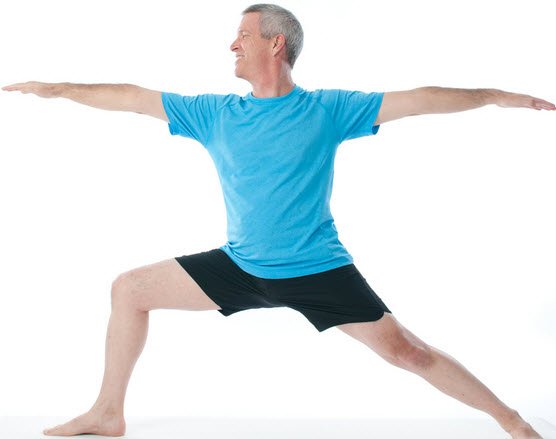
Keep the left foot straight stretched in the back and slowly lower your body, raise your arms to your sides and keep them in a straight line with the shoulders. Hold this position for 1 minute and return to the starting position. Repeat on the other side.
Wall Sitting
The wall sitting is one of the most popular isometric workouts that improve the strength and stamina in the lower part of the body, especially the claves, glutes and quadriceps. In addition, it also helps in strengthening the hamstring muscle. Stand upright with your back touching a wall. Now raise your hands straight in front of you and squat down until your thighs are parallel to the ground.
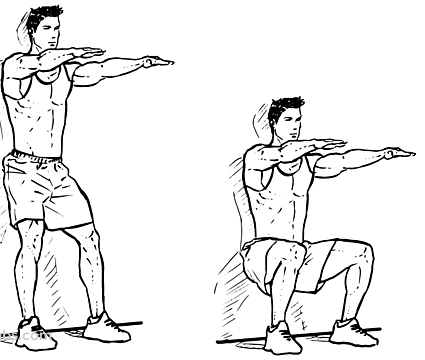
Keep your chest up and core involved at all times and don’t lean forward. Hold this posture for a count of 30 seconds to 1 minute and return to the starting position. Repeat this move 20 to 30 times.
Push Up Hold
The best isometric workout is push up hold that helps in complete conditioning of the upper body – right from the pectoral muscles to the deltoids and triceps. It also helps in toning the chest, shoulders, back muscles and arms. Begin in the plank pose and push your torso up with the help of your arms keeping your core engaged and squeeze your glutes, quads and adductors.
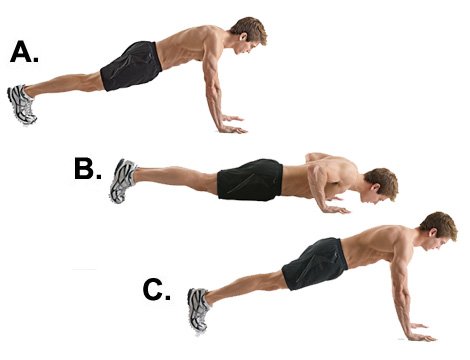
Hold the pose for 5 to 6 seconds at the top then slowly lower your body and hold it at the middle position for 5 to 6 seconds and again hold the pose at the bottom position for 5 to 6 seconds. Repeat the push ups 10 to 15 times at a stretch by pausing at the top, middle and bottom every time.
Pull Up Hold
The pull up hold and push up hold are two important parts of any isometric workout routine. It is a fundamental upper body workout that promotes muscle growth by triggering the release of growth hormones. It specifically targets the back muscles and biceps. Stand under a strong bar that you can grip comfortably. Your palms should be placed shoulder width apart and facing away from you.
Now begin with the dead hang where your arms will be fully extended and your core engaged. Now pull your body up using your upper body muscles and continue to pull up till your chin moves over the bar, hold for 5 to 8 seconds at the top, now move down and hold for another 5 to 8 seconds at the bottom. Hold the entire pose for 30 seconds and repeat again.
Side Planks
Side planks are the easiest of isometric workouts that helps in toning and strengthening the hands, forearms and knees. It targets the obliques, glutes, quadriceps, abductors and hamstrings. Begin by lying on your right side and your upper body resting on the right forearm and your left arm resting at your side.
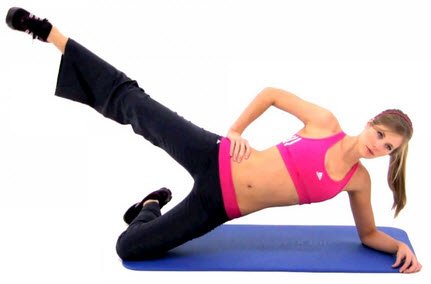
Now lift your hips from the floor by keeping your core engaged and maintaining the body in a straight line. Hold this stance for a count of 30 seconds to 1 minute and return to the starting position. Repeat the same on the other side. Replicate this move 30 times on each side.
Scapular Wall Hold
The scapular wall hold is a common isometric workout that is included in many workout routines. It helps in working the important muscles of the back and reduces the risk of injuries and strains. Stand straight with your back touching a wall. Move a few inches forward and touch your elbows to the walls by bending them at 90 degrees angle.
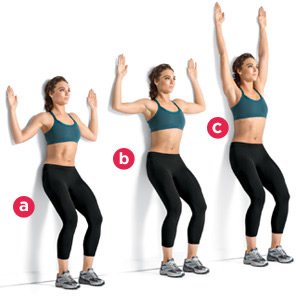
Now lean back on the wall while pressing your chest out, but don’t let your back touch the wall. Rest your head on the wall and pinch your shoulder blades back and down while squeezing your glutes and keeping your core engage. Count till 30 seconds and come back to the starting position. Repeat it 10 to 15 times at a stretch.
Glute Bridge
The Glute Bridge is one of the best workouts that help in improving the flexibility of the pelvis and lower body. It also helps in stabilizing the core muscles and hips and firms the glutes. In addition, it helps to prevent lower back pain and muscle strain. Lie on the mat and bend your knees.
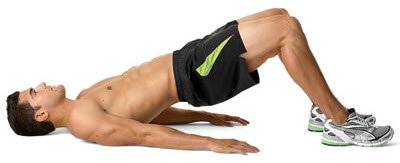
Place your feet on the ground and lift up your torso from the ground as high as you can so that it creates a straight line from the head to the knees. Keep your core involved and squeeze your glutes. Hold your weight on the heels and do not go up on the toes. Hold the pose for 30 seconds to 1 minute and return to the starting position. Repeat this move 10 to 20 times on a stretch.
Bull Dog
The bull dog pose is a common and easy to do isometric workout that helps in relaxing and strengthening the pelvic, core muscles, hips and shoulders. It is a low-intensity full-body workout to stretch all the important muscles. Begin on your hands and knees. Your hands should be directly underneath your shoulders and knees should be under the hips.
Now tuck in your toes and raise yourself up on your hands and toes so that the knees lift up from the ground, but don’t arch your back. Keep the core engaged and feel the tension build in your quads. Wait for 30 seconds to 1 minute and return to the starting position. Repeat this exercise 10 to 15 times at a stretch.
Split Squat
The split squat is often included in various fitness routines as a part of cardio or stretching exercise. This isometric workout works several muscle groups at the same time and is an effective whole body workout. It specifically targets the quadriceps, glutes, butt and lower back.
Stand straight and bring the right foot forward in a wide stance and sink down by bending your right knee so that the left knee is almost touching the ground, wait for 30 seconds to 1 minute. Now raise yourself up and bring your left leg forward and again sink down by bending your left knee so that your right knee almost touches the ground. Repeat this move with alternate feet 20 to 30 times.
Some of the Other Isometric Exercises which you simply should not Miss Out On
1) Forearm Plank
Forearm Plank, which is called the Dolphin pose in Yoga, is one great workout to work on your shoulders, arm muscles, and core.
Method
- Start with the push-up position with your body aligned straight and abs tight.
- Bend your arms at your elbows and balance your weight on your forearms.
- Hold this pose for 10 seconds and try to increase the time as you go.
2) Isometric Low Blank
Have you ever done a plank and push-up together? Well, an isometric low plank is a combination of the plank and pushup together. This is indeed a very effective exercise, as this one move can work on your core strength, arms, tummy, and shoulders, all at one go. Here is how to nail this workout.
Method
- Start with the pushup position.
- Bring your body down, bend your elbows, keep your head up, and chin
- Now slowly push your upper body up as you straighten your elbows and keep the support of your entire body weight on your arms, shoulders and your palm.
- Hold the pose for 5 seconds.
- Repeat this pose at least 10 times.
3) Shoulder Extension
Give your upper back a good stretch with the shoulder extension. This isn’t a very elaborate move; all you need to do is stand straight against a wall. This will impact your core muscles, and though it is painful initially, it does have a favorable impact on your body. Here is how you do it.
Method
- Stand straight against the support of a wall.
- Straighten your elbows while you try to stretch the shoulders ahead.
- Hold this pose for 5 seconds and release.
- Do the move at least 10 times for effective results.
4) Chest Squeeze
This chest exercise works on your chest as it contracts and expands the muscles. It is advisable that you seek the help of a qualified physician before you begin these exercises. Here is how you can do it.
Method
- Begin the exercise by standing straight with your legs be hip-width apart.
- Put your palms together and hold them for 10 seconds.
- Hold your right leg up and balance for 10 seconds.
- Once you are done with the right leg, work on your left leg next and hold the position for 10 seconds.
5) Prayer Pose
This isometric exercise won’t necessarily make you move more, but it can help strengthen your pectoral muscles.
- Place your hands together at the center of your chest.
- When you squeeze your chest muscles, press your palms together as hard as you can.
- Hold this pose for 10-20 seconds and repeat it 3-4 times.
6) Self Arm Wrestling
This is the perfect workout to work on your arms, namely, biceps and triceps. A trick to remember, do not tense your shoulders.
Method
- Bend your right arm at a 90-degree angle.
- Hold your right hand with your left hand.
- Push them together as hard as you can. Your right biceps prevents your arm from dropping while your left triceps tries to push your right arm down. Repeat on another side.
7) Calf Raises
This is one of the best exercises for your calves, so work on your calves with the following moves.
Method
- If you’re training the right calf first, stand barefoot on your right foot and spread the toes as wide as possible.
- Perform one calf raise to the peak contraction, keep your right leg locked straight.
- Squeeze and work on your peak contraction as intensely as possible by pushing through the big toe.
- Do the calf raise without any balance and support. Although it is a little hard to do, challenge yourself and repeat with the other calf.
How to Use Isometrics?
At the time of an exercise, squeeze the muscle as intensely as possible for about 5 seconds and follow it up by 5 full ranges of motion reps.
Rest for 10 seconds, and then squeeze the muscles for 4 seconds, follow it up by 4 reps.
Rest for 10 seconds again, and then squeeze it as hard as you can for another 3 seconds, follow it up by 3 full ranges of motion reps.
Rest for 3 minutes and then repeat again, and try not to reduce the resistance as much as possible. Do a total of three “sets.”
The 5-3 Countdown can ideally be used with any exercise. You can also try slightly longer durations of the squeeze if your MUSCLES grow mass with higher repetitions.
Muscles like calves, quadriceps, and deltoids, respond well with higher repetitions, so try and include a 10-8 Countdown with the standing lateral raise, for example. Limit your sets to three per workout and limit further workouts on that muscle group.
So, include these isometric workouts in your workout plan and practice it as a warm up training for at least 3 to 4 times an every week. These exercises will improve your core strength and speed up the recovery process.

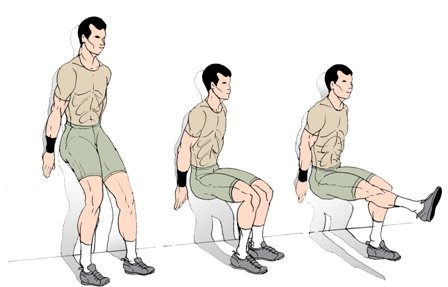

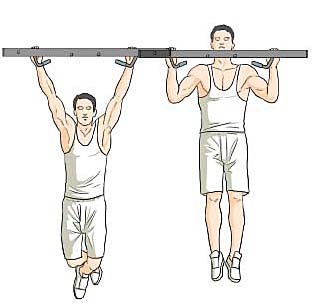
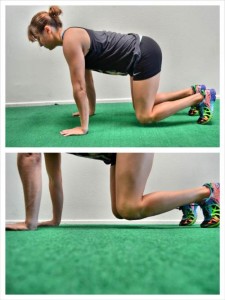
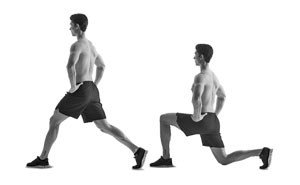
2 comments
merci bien and please deep up the GREAT WORK
Thank you so much!